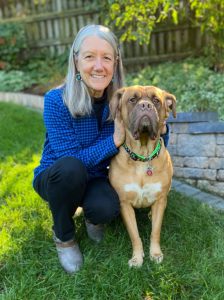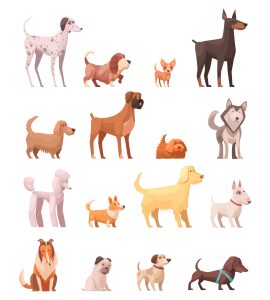
TERRY LACKMEYER
Customer Service Representative

Online is a great place to start when researching dogs. The American Kennel Club has a website loaded with information. They also publish a great book, The New Complete Dog Book, which lists all 199 of the currently recognized dog breeds. It includes synopsizes of the size, standard, and personality traits of each breed as well as what the dog was originally bred to do. Even if you are not looking for a purebred dog, reviewing the information on various breeds will help you to narrow down the sizes and traits of what you may be considering. Mixed breed dogs will carry many personality traits of purebred dogs from which they descended.
Size
When thinking about a new dog, size is very important. Are you looking for a pocket pup that you can carry around or fit into a tote Paris Hilton style? Are you leaning toward a much larger dog, like a Great Dane or Saint Bernard? Keep in mind the bigger the dog, the more expensive. This applies to not just the feeding of the dog, but also medical care. Medication is prescribed by weight so the more your dog weighs, the higher the cost of its medication. With regard to food, obviously the larger the dog the more it eats. Keep in mind, too, the type of food you want to feed. If you want to feed the newer refrigerated “fresh” foods, they are more expensive than traditional kibble and a large dog is going to require a much greater amount of food.
When considering the size of the dog, don’t forget to consider the size of your living arrangements as well. If you live in an apartment or small home with little or no backyard, a large dog that requires a lot of exercise may not be the best choice no matter how much you want that type of dog. Be sure, too, to check with your landlord if you are a renter. There may be a “no pets” clause in your lease or a restriction as to the size of dog you are permitted to own.
Time Schedule
When considering a dog, be honest about the time you have available to train and spend with the dog. A new puppy will require a lot of time, not just for the first few weeks but for several months or more. Consider the time and energy involved with housebreaking and training. Housebreaking will require that you not leave the puppy alone for long periods of time as they have little bladder control and will need frequent trips outside. Training and socializing a puppy require a very large time commitment for many, many months. In order to have a trained, well-adjusted adult dog, it is important to not underestimate the time required for raising a puppy.
If a puppy seems overwhelming, consider a slightly older dog or even a senior dog. Animal shelters and rescue organizations take in dogs of all ages and the adult dog should not be overlooked. Adult dogs will be through the chewing stage and are often already housebroken so that will save a great deal of time. Consider, too, the senior dog. They require less exercise than their younger counterpart and may be very happy to chill with you while you watch a movie or read a book if that is your lifestyle.
Activity Level
When considering that new addition, know your own lifestyle, what activities you want to do with your dog, and the exercise requirements of the dog breed. The American Kennel Club categorizes breeds into seven categories – Working, Herding, Hound, Sporting, Non-Sporting, Toy, and Terrier. Each of these groups of dogs tends to have similar characteristics. While each group does have breed exceptions, the basic characteristics tend to apply for breeds within the group.
It is important to keep those characteristics in mind when considering a breed. For example, working dogs were bred to perform specific jobs. They tend to have good stamina and are independent thinkers, which can make them a little more challenging to train. The toy breeds were bred to provide company for people of leisure which means they tend to be smaller in stature, make great lap dogs, and may not be the best choice if you are a high energy person that likes to go all day long and you expect to have your dog go with you (unless you want to carry them in a baby tote strapped to your chest).
If you like to spend the day hiking and riding your bike and hope the dog can go with you, then you may want to consider a breed that has a higher energy level. Consider one of the working, sporting, or herding breeds of dogs, such as golden retrievers, Labradors, spaniels, setters, and border collies. These dogs tend to have lots of energy and enjoy being on the go.
Likewise, if you prefer to spend your time reading a book or watching movies, you may want to consider a breed from the non-sporting or toy group. These breeds tend to be more laid back and are often times quite happy to be lap dogs. Breeds such as Cavalier King Charles Spaniels, Chihuahuas, pugs, and yorkies tend to fit into this category.
Breed and Grooming Requirements
When considering a dog, decide if you want a long or short-haired dog. Short-haired dogs require very little grooming, and their coats are easy to care for. However, don’t fall into the erroneous thinking that short-haired dogs don’t shed. Dogs shed and you will have dog hair in your home that requires additional cleaning.
Likewise, keep in mind that Pekingese, shih tzus, collies, or sheepdogs, with those long flowing locks, are beautiful to see but require lots of time for brushing and combing to keep those locks flowing and knot free. While you can take your dog to a groomer for regular grooming, you will still need to brush and comb those locks frequently between professional grooming to keep your pet’s hair from tangling and matting.
Breeds that require regular grooming can be an added expense. These breeds include poodles, bichon frises, cock-a-poos, Portuguese water dogs, and more. Regular grooming is usually every 6-8 weeks, to keep them looking their best.
Family Dynamics
When considering a dog, honestly evaluate your family dynamics. If you have small children, adding a dog will be similar to adding another child. Do you have time for a dog? No matter how much the children promise to feed, water, and walk the dog, we all know Mom and Dad are really the ones that will be caring for the dog.
Speaking of children, keep in mind that some breeds are inherently better with children than others. Those breeds with easy going personalities and lots of energy, such as golden retrievers and Labradors, tend to be great family dogs.
While it’s nice to get a puppy and have them mature with the kids, don’t overlook the benefits of a slightly older dog. An older dog will be through the chewing stage and probably housebroken which is a big plus. A dog that is 1-2 years old is young enough to grow with the kiddies and provide years of friendship yet spare you the housebreaking time and chewing worries.
Taking the time to research dogs is well worth the effort involved. Keep in mind that each dog is an individual, just like people, and may not match a particular breed profile exactly. While this article frequently mentions purebreds, I am by no means pushing purebred dogs. Mixed breeds make wonderful companions and often times have fewer medical problems than their purebred counterparts.
You will be spending the next 10-12 years sharing your life with this four-footed friend. Making sure that they fit into the lifestyle and activity level of you and your family, and you can meet the needs of the dog will make happier, healthier lives for everyone involved – both human and canine.
